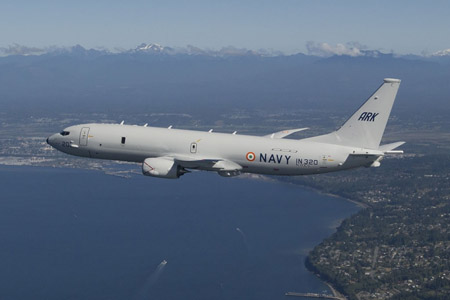 New Delhi, Jan 17: The Boeing P8-I long-range maritime reconnaissance aircraft (LRMRA) which the Indian Navy got lat month is the most sophisticated weapon system in its inventory yet.
New Delhi, Jan 17: The Boeing P8-I long-range maritime reconnaissance aircraft (LRMRA) which the Indian Navy got lat month is the most sophisticated weapon system in its inventory yet.
The aircraft, which is now being used for training by Indian naval personnel in coordination with the US Navy in the US, has the latest radars, electronic warfare systems, and weapons to kill hostile submarines, several of which lurk underwater in the Arabian Sea and Bay of Bengal around the Indian coast.
Built on the body of a civilian Boeing 737-800 jetliner with the wings of a 737-900, the P8-I is actually an attack aircraft, capable of discriminating between friendly and hostile vessels far away and then hit them with desired priority and lethality.
Its key capability though is to detect and delete hostile submarines, as also small boats in shallow waters which pose the most serious threat to Indian naval assets.
India has purchased eight P8-Is from the US Navy under the US government’s Foreign Military Sales (FMS) programme and the government has cleared four more for which there was an option. Another 12 P8-Is, or similar aircraft, should be acquired later.
The $2.1 billion-plus deal for aircraft covers onboard offensive and defensive systems and training. Weapons like the Boeing Harpoon Block II missiles, sonobuoys, Raytheon’s Mk 54 torpedoes, some freefall weapons cost additional.
The P8-I is a derivative of the US Navy’s P8-A multi-mission maritime aircraft (MMA) developed at the cost of billions of dollars. The first P8-A was delivered to it in March 2012, and so far, it has received five of the 117 ordered aircraft.
The Indian Navy is the first foreign customer and not much apart in time.
Understandably though, the P8-Is would not have the same range and features as the P8-As, but then the Indian requirements are met appropriately. In any case, there cannot be 100 per cent commonality as neither would the US share its latest technologies nor is India looking for interoperability with US assets.
Mission computers form the heart of the P8-I, integrating various sensors, radars and weapons on board, directing their power, reach and the required urgency in neutralizing hostile targets.
There are five to seven consoles for the operators, who can command the system to initiate and execute real-time action and attack.
Although the P8-I is not an AWACS (airborne warning and control systems) aircraft, it can operate as one in a limited way, and coordinate with the Indian Navy or Indian Air Force (IAF) combat jets to shower hell on an enemy.
The Indian P8-Is will be integrated with the Indian Navy and IAF assets, including fighters, AWACS and ground stations, thanks to net-centricity. Both the Navy and IAF fly Mig 29s for instance, and in the recent years, all the three services are approaching war-fighting with an emphasis on jointness.
The three services periodically hold joint exercises, and one such is due between the Indian Navy and IAF around March. Once the P8-I start arriving from mid-2013 onwards, there would be more exercises.
Meanwhile, the infrastructure to operate the P8-Is is being built at INS Rajali at Arakkonam Naval Air Station in Tamil Nadu, from where the aircraft can easily fly towards the Bay of Bengal or the Arabian Sea. All the 12 aircraft will be based there.
Notably, unlike the earlier aircraft used for maritime reconnaissance and attack role, the four-engined Il-38 and Tu 142 which the Indian Navy has, or the Orion P3C which the US Navy has been flying so far, the P8-I is a jet with jet speed. Its two CFM 56 engines have, however, been tweaked to allow it to fly slow, and low above water.
The acquisition of the P8-I has brought to the Indian Navy some of the most sophisticated radar and other systems, particularly Raytheon’s AN/APY-10 multi-mission surface search radar with a range of 200-400 km. This forward-looking Synthetic Aperture Radar (SAR) with 240 degree coverage is built on the technology of the famed AESA (Active Electronically Scanned Array) radar that the (IAF) wants on all its combat aircraft, beginning with the Multi Role Combat Aircraft (MRCA) being negotiated now.
To ensure 360 degree scanning however, the Indian Navy has got an aft radar from US Telephonics for rear coverage.
The US Navy aircraft do not need aft radars as there are several US surveillance assets, including aircraft and satellites, in the sky at any time. The P-8A however is primarily meant to function in alignment with the unmanned Broad Area Maritime Surveillance (BAMS) aircraft (designated MQ-4C Triton), which is still under development by Northrop Grumman.
The P8-I has some systems supplied by Indian companies to make its communications secure and compatible with Indian naval and air assets.
They include Data Link II (communication system) from Bharat Electronics, IFF (Identify Friend or Foe system) transponder from HAL (Hindustan Aeronautics Ltd), speech secrecy system from ECIL (Electronics Corporation of India Ltd) and mobile SATCOM (satellite communication system) from Avantel. All the P8-Is, as well as other navy aircraft now have net-centric capabilities and interoperability with IAF aircraft and ground stations.
India received the first P8-I when Cmde Alok Bhatnagar, naval attache at the Indian embassy in Washington and other Indian Navy officers received it on-site in Seattle in accordance with the contract awarded in 2009.
Indian naval pilots, systems operators and technicians, some of whom have been stationed there to monitor the progress of the project and some others, will now conduct test and training flights with US Navy assistance before this aircraft is brought home.
India will receive two more fully-equipped P-8Is within 2013, and all the eight by 2015.
A Boeing statement said that the manufacturing programme is progressing on schedule, and that Boeing is already assembling the fourth and fifth P-8Is.





Comments
Add new comment